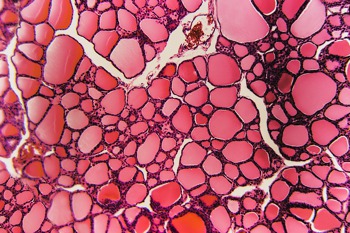
Hypothyroidism is an endocrine condition in dogs which occurs when there is a reduced production and release of the thyroid hormones. Thyroid hormones have many important and varied functions and act on nearly every tissue in the body.
Their presence at the correct levels is therefore vital to ensure a happy, healthy dog. Once hypothyroidism is diagnosed in a dog it can usually be treated and the prognosis is good, although affected dogs will need to receive treatment throughout their whole lives.
What is the Thyroid Gland?

Cells from a Dog's Thyroid Gland
The thyroid is a small endocrine gland that can be found on the ventral or bottom side of the neck towards the head, just in front of the trachea or windpipe. It is responsible for producing two different types of hormones:
- Those which contain iodine: T3 or tri-iodothyronine and T4 or thyroxine. Other tissues can convert T4 into T3, which is the more active form. These hormones are responsible for controlling the body’s metabolic rate and also help to regulate how fast some tissues grow. Whether the thyroid gland releases them into the body is controlled by another hormone called thyroid stimulating hormone (TSH) that comes from a part of the brain called the pituitary gland.
- Calcitonin which is responsible for controlling calcium levels in the blood.
There is a complex series of interlinked events and reactions that leads to the release of thyroid hormones and helps regulate their levels. The hormones themselves are involved in the complex regulation and control of processes in many different body systems and play an essential role in body metabolism and the basal metabolic rate.
What is Hypothyroidism?
Hypothyroidism is a condition which occurs when the body is unable to produce or release thyroid hormones or cannot respond adequately to their presence. There are different types of hypothyroidism depending on where the problem is occurring in the function of the thyroid.
Thyroid hormone production is controlled by a complicated series of events in different areas of the body that form the hypothalamic-pituitary-thyroid axis. Levels of hormones at different stages feedback into the cycle and therefore influence future outcomes of the way it works.
Types of Hypothyroidism in Dogs
Depending on the origin of the hypothyroidism it can divided into different types:
- Primary Hypothyroidism: This is the principal type of hypothyroidism and causes 90 – 95 % of cases. There are various different conditions which can cause primary hypothyroidism. These include:
- Lymphocytic thyroiditis – This is the most frequent cause of primary hypothyroidism in dogs and is thought to be an autoimmune condition that gradually destroys certain parts of the thyroid gland.
- Atrophy or wasting of the thyroid – Thyroid tissue becomes atrophied or wasted and is gradually replaced by fatty tissue.
- Thyroid tumours – Tumours which affect thyroid function can cause primary hypothyroidism. They can be primary or secondary, although they are rare.
- Secondary Hypothyroidism: In this type of hypothyroidism, the pituitary gland is affected. There is a reduction in the amount of thyroid stimulating hormone, which the pituitary gland secretes. This leads to a wasting effecting on some cells in the thyroid gland itself. Tumours or abnormalities present from birth in the pituitary can be responsible for causing this. It represents a small percentage – 5 to 10% of the overall number of cases of hypothyroidism.
- Tertiary Hypothyroidism: This type of hypothyroidism is rare and not particularly well studied, but affects the production or release of thyroid releasing hormone (TRH) in the hypothalamus in the brain. Thyroid releasing hormone is usually responsible for stimulating the release of thyroid stimulating hormone from the pituitary gland.
- Iodine Deficiency: Although extremely rare, iodine deficiency can also cause hypothyroidism.
- Peripheral Hypothyroidism: This type of hypothyroidism occurs when the body fails to convert the less active T4 thyroid hormone into the more active T3 form or for some reason tissues become resistant to their presence. Both types of peripheral hypothyroidism are rare.
How Do Dogs Get Hypothyroidism?

Hypothyroidism in dogs can either be a congenital (an abnormality present from birth) condition or a metabolic condition which develops at some point in a dog’s life, potentially caused by a number of different abnormalities.
When are Dogs Most at Risk from Hypothyroidism?
It seems that larger breeds of dogs are most at risk from hypothyroidism and some breeds are more prone to it than others. The congenital form of the disease usually develops before six months of age and the acquired form of hypothyroidism usually occurs before or around middle age, which is two to three years old in predisposed, large and giant breeds, and six to ten years old in other breeds. Although hypothyroidism does not seem to occur more commonly in males than females, spayed females appear to have a higher risk of developing the condition than unneutered females.
Which Breeds Are Most Commonly Affected by Hypothyroidism?
There are some breeds which seem to have a higher predisposition to being affected by hypothyroidism than others. These include:
- Airedale Terrier
- Boxer
- Cavalier King Charles Spaniel
- Cocker Spaniel
- Dachshund
- Doberman
- Golden Retriever
- Irish Setter
- Miniature Schnauzer
- Old English Sheepdog
Symptoms of Hypothyroidism
The clinical symptoms associated with hypothyroidism are quite vague and non-specific as the thyroid hormones T3 and T4 have some kind of effect on nearly every tissue in the body. The symptoms hypothyroidism causes could also be caused by many other conditions and the disease is thought to be over diagnosed. Some of the symptoms of the disease include:
- A tendency to become overweight or obese without eating excessively
- General tiredness, mental dullness and low exercise resistance
- Affected more than normal by cold temperatures and searching for warm places
- A sudden change of character and uncharacteristic aggressive episodes
- Symmetrical alopecia on both sides of the body with some other skin signs, as well as thickening of the skin and increase in the amount of pigment present in the skin; There may also be changes in the colour of the coat, as well as more shedding than usual
- Dogs can also be more prone to suffering from yeast infections and mite infestations
- Reproductive problems
- Although not visually obvious hypothyroidism can cause a slowing of the heart rate and other effects on the heart
- Hypothyroidism can cause a number of eye abnormalities
- In young dogs hypothyroidism can cause dwarfism
Diagnosis of Hypothyroidism in Dogs
Diagnosis of hypothyroidism in dogs is based predominantly on clinical signs, but generally a mixture of these signs is more likely to suggest that a dog is suffering from hypothyroidism than just any isolated symptom. A dog’s treatment history should also be reviewed to ensure that any symptoms of hypothyroidism are not being caused by any drugs that can suppress thyroid function and mimic the condition.
Other diseases should be excluded by performing routine blood tests. If blood test results are indicative of possible hypothyroidism, then more specific tests can be done to investigate thyroid function. A skin biopsy is another procedure that can be useful in the diagnosis of hypothyroidism. Using a trial of treatment should never be used to diagnose hypothyroidism as some conditions, which can cause similar signs, may either be allowed to progress and thereby go unnoticed or simply improve with time – as is the case in some alopecias.
Can Hypothyroidism in Dogs Be Treated?
Hypothyroidism can be treated in dogs by giving artificial thyroid hormone supplementation. The most common treatment is with L-thyroxine (T4), which can be given in tablet form. The body then converts this to T3. Due to the long time frame needed for supplementation to have an effect around two to three months of treatment is often needed before a dramatic improvement in clinical signs is seen.
In cases where treatment is needed more urgently, T3 can be used as a treatment, however, it is more costly and needs to be given on a more frequent basis. When using thyroid hormone replacement treatments dogs must be regularly tested to ensure that the dose they are receiving is appropriate. Your veterinarian will suggest an appropriate schedule for this testing but it will be approximately every 6 to 12 months once a dog appears to be stable with a clear reduction of clinical signs due to a particular treatment.
In addition to treating hypothyroidism it is important to treat any conditions, such as diabetes of heart conditions, which may also be present and are often seen concurrently.
Prognosis is good for hypothyroidism if it is treated correctly with sufficient levels of drugs to mimic thyroid hormone levels, and medication is given consistently. Treatment is life-long, requiring dedication from the owner.
Other Conditions Which Can Be Confused with Hypothyroidism
Correctly diagnosing hypothyroidism is essential, as there are a number of other conditions which can cause similar signs and if these persist treatment for hypothyroidism will not make any difference. These may include:
- Hyperadrenocorticism
- Sick euthyroid syndrome
- Other causes of a reduced heart rate
- Other causes of alopecia
The Importance of Treating Hypothyroidism
Hypothyroidism is a condition which can be treated relatively easily in most cases once it has been correctly diagnosed. Although treatment is necessary for the rest of a dog’s life it usually has a good outcome and can lead to a dramatic improvement in a dogs’ quality of life. Clinical signs can be reduced or completely eliminated and the dog can return to normal activity.
References
- Dixon, R.M., Graham, P., et al. (1997). Comparison of endogenous serum thyrotropin (cTSH) concentrations with bovine TSH response test. Results in euthyroid and hypothyroid dogs. JVIM: 11, 121.
- Dixon, R.M. & Mooney, C.T. (1999). Evaluation of serum free thyroxine and thyrotropin concentrations in the diagnosis of canine hypothyroidism. JSAP: 40 (2), 72-78.
- Ferguson, D.C. (1988). The effect of nonthyroidal factors on thyroid function test in dogs. Comp Cont Ed Pract Vet: 10, 1365-1377.
- Ferguson, D.C. (1994). Update on the diagnosis of canine hypothyroidism. Vet Clin North Am Sm Anim Pract: 24, 515-539.
- Frank, L.A. (1996). Comparison of TRH to TSH stimulation for evaluating thyroid function in dogs. JAAHA: 32, 481-487.
- Graham, P. (2009). Canine hypothyroidism: diagnosis and therapy. In Practice: 31, 77-82.
- Hess, R.S. & Ward, C.R. (1998). Diabetes mellitus, hyperadrenocorticism, and hypothyroidism in a dog. JAAHA: 34, 204-207.
- Muller, G., et al. (1995). Muller and Kirk's Small Animal Dermatology. 5th edn. Philadelphia: W B Saunders. pp 691-703.
- Kemppainen, R.J. & MacDonald, J.M. (1993). Canine hypothyroidism. In: Current Veterinary Dermatology - the Science and Art of Therapy. Griffin, C.E., Kwochka, K.W. & Macdonald, J.M. 1st ed. St Louis: Mosby Year Book. pp 265-272.
- Pancieria, D.L. (1990). Canine hypothyroidism. Part II. Thyroid function tests and treatment. Comp Cont Ed Pract Vet: 12, 843-858.
- Panciera, D.L. (1999). Is it possible to diagnose hypothyroidism? JSAP: 40 (4), 152-157.
- Peterson, M.E. & Ferguson, D.C. (2005). Thyroid diseases. In: Textbook of Veterinary Internal Medicine, 2 (6) Ed: Ettinger, S.J, Philadelphia: Saunders, W.B. pp 1632-1675.
- Ramsey, I.K. (1997). Diagnosing canine hypothyroidism. In Practice: 19, 378-383.

